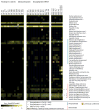Enrichment of Retroviral Sequences in Brain Tissue from Patients with Severe Demyelinating Diseases
- PMID: 29202119
- PMCID: PMC5707126
- DOI: 10.16966/2473-1846.132
Enrichment of Retroviral Sequences in Brain Tissue from Patients with Severe Demyelinating Diseases
Abstract
Background: Our group has used deep sequencing to identify viral RNA signatures in human brain specimens. We have previously used this method to detect HSV1, GBV-C, and measles virus sequence in brain tissue from deceased donors. Deep sequencing was performed on brain specimens from a cohort of patients who died with progressive forms of MS, revealing evidence of increased expression of some human endogenous retrovirus (HERV) domains.
Objectives: Identify RNA sequences and new antigens involved in the pathogenesis of MS.
Methods: Deep sequencing was performed on RNA extracted from 12 progressive MS, 2 neuromyelitis optica (MS/NMO = demyelination group), 14 normal control, and 7 other neurologic disease (OND) control frozen brain specimens. The resulting single-ended 50 bp sequences (reads) were compared to a non redundant viral database representing (NRVDB) all 1.2 M viral records in GenBank. A retroviral gene catalog (RVGC) was prepared by identifying human genetic loci (GRCh37.p13) homologous to domains contained in the Gypsy 2.0 retro element database. Reads were aligned to the RVGC and human transcriptome with Bowtie2. The resulting viral hit rates (VHRs) were normalized by the number of high quality reads. The expression of human genes, including HERVs, was determined using Cufflinks. Comparisons between the groups were performed using the false discovery rate.
Results: Fifty to 131 million high quality reads per specimen were obtained. Comparison of the reads to the NRVDB suggested that the demyelination and OND specimens had higher VHRs against some retroviral sequences compared with the controls. This was confirmed by retroviral domain averaging. Gene expression analysis showed differential expression among some HERV sequences. Single read mapping revealed one envelope and one reverse transcriptase sequence record that were significantly enriched among the demyelination samples compared to the normal controls. Less restrictive (comprehensive) read mapping showed that 2 integrase, 2 core, 2 envelope, and 3 KRAB sequences that were overexpressed in the demyelination group.
Conclusions: These data demonstrate that some endogenous retroviral sequences are significantly overexpressed in these demyelination brain tissue specimens, but the magnitude of this overexpression is small. This is consistent with the concept of HERV activation as a part of the innate immune response.
Keywords: Deep sequencing; Endogenous retroviruses; HERV; Multiple sclerosis; Next generation sequencing; Progressive MS; RNA-seq.
Figures


Similar articles
-
Analysis of Human Endogenous Retrovirus Expression in Multiple Sclerosis Plaques.J Emerg Dis Virol. 2017 Aug;3(2):10.16966/2473-1846.133. doi: 10.16966/2473-1846.133. Epub 2017 Jul 24. J Emerg Dis Virol. 2017. PMID: 28868516 Free PMC article.
-
Deep sequencing for the detection of virus-like sequences in the brains of patients with multiple sclerosis: detection of GBV-C in human brain.PLoS One. 2012;7(3):e31886. doi: 10.1371/journal.pone.0031886. Epub 2012 Mar 8. PLoS One. 2012. PMID: 22412845 Free PMC article.
-
Unbiased examination of genome-wide human endogenous retrovirus transcripts in MS brain lesions.Mult Scler. 2021 Oct;27(12):1829-1837. doi: 10.1177/1352458520987269. Epub 2021 Jan 19. Mult Scler. 2021. PMID: 33464158
-
Utility of next-generation RNA-sequencing in identifying chimeric transcription involving human endogenous retroviruses.APMIS. 2016 Jan-Feb;124(1-2):127-39. doi: 10.1111/apm.12477. APMIS. 2016. PMID: 26818267 Review.
-
Human endogenous retroviruses in neurologic disease.APMIS. 2016 Jan-Feb;124(1-2):116-26. doi: 10.1111/apm.12486. APMIS. 2016. PMID: 26818266 Review.
Cited by
-
A Systematic Review of Tissue and Single Cell Transcriptome/Proteome Studies of the Brain in Multiple Sclerosis.Front Immunol. 2022 Mar 2;13:761225. doi: 10.3389/fimmu.2022.761225. eCollection 2022. Front Immunol. 2022. PMID: 35309325 Free PMC article.
-
Analysis of Human Endogenous Retrovirus Expression in Multiple Sclerosis Plaques.J Emerg Dis Virol. 2017 Aug;3(2):10.16966/2473-1846.133. doi: 10.16966/2473-1846.133. Epub 2017 Jul 24. J Emerg Dis Virol. 2017. PMID: 28868516 Free PMC article.
-
Deciphering the viral landscape in gastric cancer: comprehensive characterization and identification of the gastric cancer virome.mBio. 2025 Aug 13;16(8):e0055125. doi: 10.1128/mbio.00551-25. Epub 2025 Jul 9. mBio. 2025. PMID: 40631867 Free PMC article.
-
The Role of Herpes Simplex Virus Type 1 Infection in Demyelination of the Central Nervous System.Int J Mol Sci. 2020 Jul 16;21(14):5026. doi: 10.3390/ijms21145026. Int J Mol Sci. 2020. PMID: 32708697 Free PMC article. Review.
-
Viruses and Endogenous Retroviruses as Roots for Neuroinflammation and Neurodegenerative Diseases.Front Neurosci. 2021 Mar 12;15:648629. doi: 10.3389/fnins.2021.648629. eCollection 2021. Front Neurosci. 2021. PMID: 33776642 Free PMC article. Review.
References
-
- Kurtzke J. Epidemiology and etiology of multiple sclerosis. Phys Med Rehab Clin N Am. 2005;16:327–349. - PubMed
-
- Kurtzke JF. Multiple sclerosis in time and space--geographic clues to cause. J Neurovirol. 2000;6:S134–140. - PubMed
-
- Meinl E. Concepts of viral pathogesis of Multiple Sclerosis. Curr Opin Neurology. 1999;12:303–307. - PubMed
Grants and funding
LinkOut - more resources
Full Text Sources
Other Literature Sources
